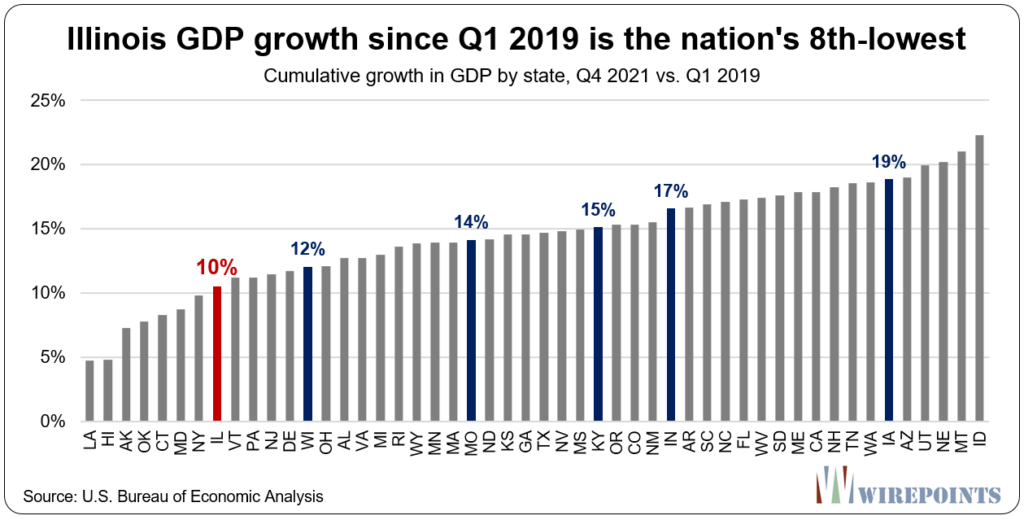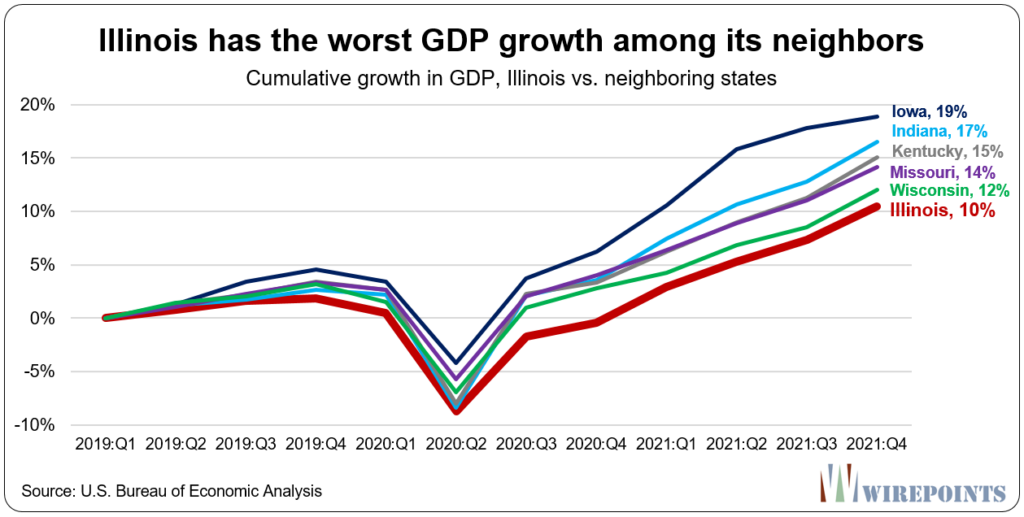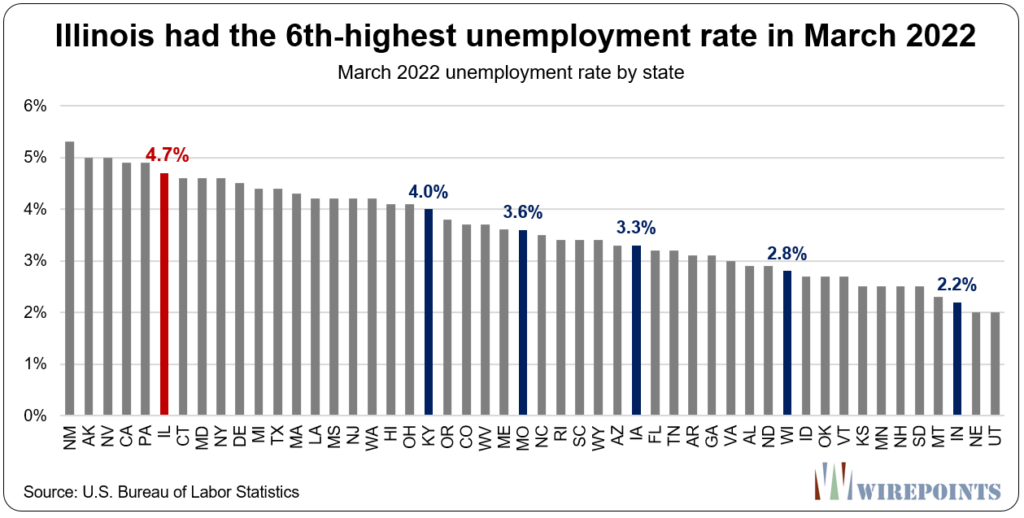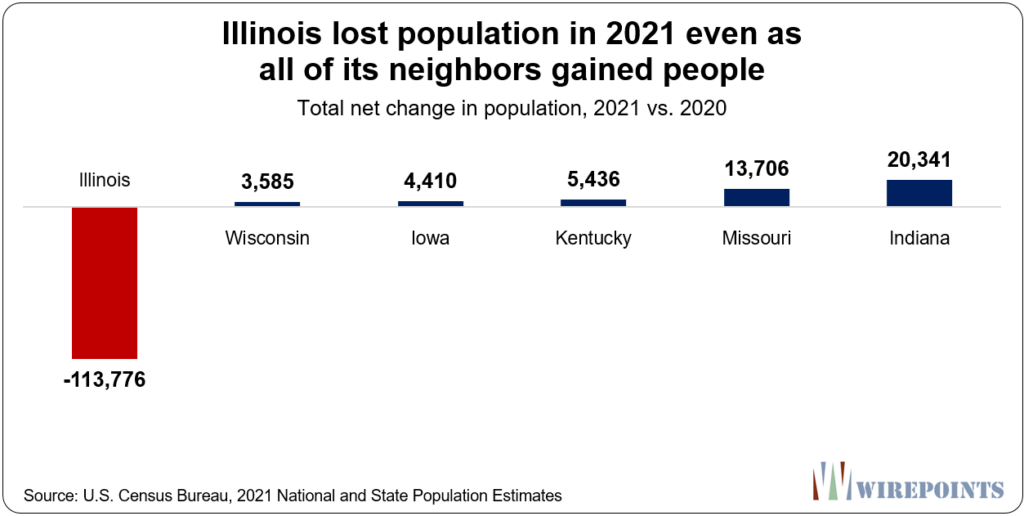It’s amazing what nearly $200 billion in federal COVID aid can do to paper over a state’s crumbling finances. Illinois’ state tax revenues are temporarily at record levels, the unpaid bills backlog has been cut and Illinois even saw its credit rating saved from the precipice of junk. Comptroller Susana Mendoza recently called the state’s changed circumstances an “absolutely remarkable turnaround.”
But while “free” federal money might make Illinois’ finances look better temporarily, the state continues to struggle where it really matters – economic growth and job creation.
Since the beginning of 2019 when Gov. Pritzker took office, Illinois has continued to lag most of the nation in GDP growth and its unemployment rate remains one of the highest in the country.
 Less relative economic output and fewer jobs leads to one thing over time: a shrinking population. Illinois was one of just three states to shrink over the past decade and the state lost a record number of people last year.
Less relative economic output and fewer jobs leads to one thing over time: a shrinking population. Illinois was one of just three states to shrink over the past decade and the state lost a record number of people last year.
From a recent Pew report: “Population trends are tied to states’ economic fortunes and government finances. More people usually means more workers and consumers adding to economic activity as they take jobs and buy goods and services, which generates more tax revenue. A growing economy, in turn, can attract even more workers and their families. The reverse is usually true for states with shrinking or slow-growing populaces.”
No amount of federal money can overcome Illinois’ anti-competitive policies, its dominant public-sector unions, a poor business environment, systemic corruption and overwhelming debts. The only way to fix any of those issues is with structural spending and governance reforms, something Illinois’ political leadership continues to ignore.
Here’s what you need to know about Illinois’ economic reality over the last three years:
GDP growth
Illinois has lagged its neighbors in GDP as the nation has recovered from the pandemic’s economic shutdowns. Illinois was behind its neighbors in growth before the pandemic; it suffered the deepest collapse compared to its neighbors, and even now it continues to lag during the recovery.
Overall, Illinois’ cumulative GDP growth from Q1 2019 to Q4 2021 totaled just over 10 percent, according to the U.S. Bureau of Economic Analysis. Iowa’s GDP, in contrast, has grown nearly double that: 19 percent. Missouri, Kentucky and Indiana also grew by around 15 percent.
If Illinois’ then-$880 billion GDP had grown at the same pace as Iowa’s, Illinois would have produced $80 billion in additional output over the period.

Illinois’ poor recovery is even more obvious when compared to the rest of the nation. Illinois’ GDP growth over that same period has been the 8th-lowest in the nation, only ahead of states like New York, Connecticut, Alaska and Hawaii.
 Unemployment
Unemployment
Illinois also lags its neighbors and most of the nation when it comes to jobs. The state’s unemployment rate peaked at 17.4 percent early on in the pandemic – the highest of all of Illinois’ neighbors – and it continues to be the worst performer.
 Illinois’ most recent unemployment rate of 4.7 percent in March 2022 was the nation’s 6th-highest, according to the U.S. Bureau of Labor Statistics.
Illinois’ most recent unemployment rate of 4.7 percent in March 2022 was the nation’s 6th-highest, according to the U.S. Bureau of Labor Statistics.
Kentucky has a 4 percent unemployment rate. Iowa’s is 3.3 percent. And Indiana’s rate is just 2.2 percent, the 3rd-lowest in the nation. If Illinois had the same unemployment rate as Indiana’s, 160,000 more Illinoisans would be employed today.
 Population
Population
Unsurprisingly, Illinois long-running dysfunction combined with the state’s prolonged lockdowns and unnecessarily harsh mitigations during Covid created a perfect storm for population losses.
Illinois lost a record 114,000 people between 2020 and 2021, while our neighbors all grew in population, according to U.S. Census Bureau data.
Meanwhile, big winners Texas and Florida gained 310,000 and 262,000 people, respectively.
 Illinois’ record decline once again made it a national outlier. The state’s loss equaled nearly 1 percent of population, the nation’s 2nd-worst decline behind only New York.
Illinois’ record decline once again made it a national outlier. The state’s loss equaled nearly 1 percent of population, the nation’s 2nd-worst decline behind only New York.
In contrast, popular destination states like Idaho, Utah and Montana all grew more than 1.5 percent. The already big states like Texas and Florida grew by around 1 percent.

Illinois’ 2021 loss followed its dismal record of the past decade. Illinois was one of just three states to shrink between 2010 and 2020 along with Mississippi and West Virginia.
*******************************
Too many Illinois politicians are taking credit for the state’s “better” finances while denying the role the federal bailout played. It’s only fair for those same politicians to be held responsible for Illinois’ dismal economic record.
